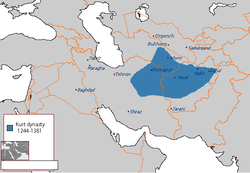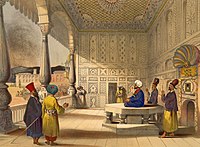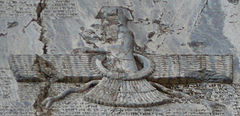Kart dynasty
Kart dynasty آل کرت | |||||||||
|---|---|---|---|---|---|---|---|---|---|
| 1244–1381 | |||||||||
 The Kart dynasty at its greatest extent | |||||||||
| Status | Monarchy | ||||||||
| Capital | Herat | ||||||||
| Common languages | Persian | ||||||||
| Religion | Sunni Islam | ||||||||
| Malik/Sultan | |||||||||
• 1245 | Malik Rukn-uddin Abu Bakr (first) | ||||||||
• 1370–1389 | Ghiyas-uddin Pir 'Ali (last) | ||||||||
| Historical era | Middle Ages | ||||||||
• Foundation by Malik Rukn-uddin Abu Bakr | 1244 | ||||||||
• Disestablished | 1381 | ||||||||
| |||||||||
| Today part of | Afghanistan Iran Turkmenistan | ||||||||
The Kart dynasty, also known as the Kartids (
Vassals of the Ghurid dynasty
The Karts trace their lineage to a Tajuddin Uthman Marghini, whose brother, 'Izzuddin Umar Marghini, was the Vizier of Sultan
Malik Rukn-uddin Abu Bakr married a Ghurid princess.[4] Their son Shams-uddin succeeded his father in 1245.
Vassals of the Mongol Empire

Shams-uddin Muhammad succeeded his father in 1245, joined
Fakhr-uddin was a patron of literature, but also extremely religious. He had previously been cast in prison by his father for seven years, until the
Sham-suddin Muhammad was succeeded by his son Rukn-uddin. The latter adopted the title of Malik (Arabic for king), which all succeeding Kart rulers were to use. By the time of his death; in Khaysar on 3 September 1305, effective power had long been in the hands of his son Fakhr-uddin.
Fakhr-uddin's brother Ghiyath-uddin succeeded him upon his death; almost immediately, he began to quarrel with another brother, Ala-uddin ibn Rukn-uddin. Taking his case before Oljeitu, who gave him a grand reception, he returned to Khurasan in 1307/8. Continuing troubles with his brother led him to visit the Ilkhan again in 1314/5. Upon returning to Herat, he found his territories being invaded by the
Independent principality
Four years after Mu'izz-uddin Husayn ibn Ghiyath-uddin's ascension, the Ilkhan Abu Sa'id Bahadur Khan died, following which the Ilkhanate quickly fragmented. Mu'izz-uddin Husayn, for his part, allied with
Vassals of the Timurids
Ghiyas-uddin Pir 'Ali, a grandson of Togha Temür through his mother Sultan Khatun, attempted to destabilize the Sarbadars by stirring up the refugee dervishes within his country. 'Ali-yi Mu'ayyad countered by conspiring with Malik Muhammad. When Ghiyas-uddin Pir 'Ali attempted to remove Malik Muhammad, 'Ali-yi Mu'ayyad flanked his army and forced him to abort the campaign, instead compromising with his stepbrother. The Sarbadars, however, soon suffered a period of internal strife, and Ghiyas-uddin Pir 'Ali took advantage of this by seizing the city of Nishapur around 1375 or 1376. In the meantime, both Ghiyas-uddin Pir 'Ali and Malik Muhammad had asked for the assistance of Timur regarding their conflict: the former had sent an embassy to him, while the latter had appeared before Timur in person as a requester of asylum, having been driven out of Sarakhs. Timur responded to Ghiyas-uddin Pir 'Ali by proposing a marriage between his niece Sevinj Qutluq Agha and the Kart ruler's son Pir Muhammad ibn Ghiyas-uddin, a marriage which took place in Samarkand around 1376. Later on, Timur invited Ghiyas-uddin Pir 'Ali to a council, so that the latter could submit to him, but when the Kart attempted to excuse himself from coming by claiming he had to deal with the Shia population in Nishapur, Timur decided to invade. He was encouraged by many Khurasanis, included Mu'izzu'd-Din's former vizier Mu'in al-Din Jami, who sent a letter inviting Timur to intervene in Khurasan, and the shaikhs of Jam, who, being very influential persons, had convinced many of the Kart dignitaries to welcome Timur as the latter neared Herat. In April 1381, Timur arrived before the city, whose citizens were already demoralized and also aware of Timur's offer not to kill anyone that did not take part in the battle. The city fell, its fortifications were dismantled, theologians and scholars were deported to Timur's homeland, a high tribute was enacted, and Ghiyas-uddin Pir 'Ali and his son were carried off to Samarkand. Ghiyas-uddin Pir 'Ali was made Timur's vassal, until he supported a rebellion in 1382 by the maliks of Herat. Ghiyas-uddin Pir 'Ali and his family were executed around 1383, and Timur's son Miran Shah destroyed the revolt. That same year, a new uprising led by a Shaikh Da'ud-i Khitatai in Isfizar was quickly put down by Miran Shah. The remaining Karts were murdered in 1396 at a banquet by Miran Shah.[7] The Karts therefore came to an end, having been the victims of Timur's first Persian campaign.
Rulers
| Titular Name | Personal Name | Reign | Notes |
|---|---|---|---|
| Malik Rukn-uddin Abu Bakr | ?-1245 | ||
| Shams-uddin Muhammad bin Abu Bakr | 1245-1277 | ||
| Malik ملک Shams-uddin -i-Kihin |
Rukn-uddin ibn Sham-suddin Muhammad | 1277–1295 | |
| Malik ملک |
Fakhr-uddin ibn Rukn-uddin |
1295–1308 | |
| Malik ملک |
Ghiyath-uddin ibn Rukn-uddin |
1308–1329 | |
| Malik ملک |
Shams-uddin Muhammad ibn Ghiyath-uddin | 1329-1330 | |
| Malik ملک |
Hafiz ibn Ghiyath-uddin | 1330–1332 | Hafiz, a scholar and the next person to take the throne, was murdered after two years. |
| Malik ملک Sultan سلطان |
Mu'izz-uddin Husayn ibn Ghiyath-uddin | 1332–1370 | |
| Malik ملک Sultan سلطان |
Ghiyas-uddin Pir 'Ali & Malik Muhammad ibn Mu'izz-uddin under whom were initially Sarakhs and a portion of Quhistan |
1370–1389 | |
| Conquest of Greater Khorasan and Afghanistan by Amir Timur Beg Gurkani. | |||
The colored rows signify the following;
- Yellow – under Ghurid dynasty suzerainty
- Orange – under Mongol Empire and later Ilkhanate suzerainty
- Gray – Independent
- Pink – under Timuridsuzerainty
Family Tree
| Kartid Dynasty | ||||||||||||||||||||||||||||||||||||||||||||||||||||||||||||||||||||||||||||||||||||||||||||||||||||||||||||||||||||||||||||||||||||||||||||||||||||||||||||||||||||||||||||||||||||||||||||||||||||||||||||||||||||||||||||||||||||||||||||||||||||||||||||||||||||||||||||||||||||||||||||||||||||||||||||||||||||||||||||||||||||||||||||||
|---|---|---|---|---|---|---|---|---|---|---|---|---|---|---|---|---|---|---|---|---|---|---|---|---|---|---|---|---|---|---|---|---|---|---|---|---|---|---|---|---|---|---|---|---|---|---|---|---|---|---|---|---|---|---|---|---|---|---|---|---|---|---|---|---|---|---|---|---|---|---|---|---|---|---|---|---|---|---|---|---|---|---|---|---|---|---|---|---|---|---|---|---|---|---|---|---|---|---|---|---|---|---|---|---|---|---|---|---|---|---|---|---|---|---|---|---|---|---|---|---|---|---|---|---|---|---|---|---|---|---|---|---|---|---|---|---|---|---|---|---|---|---|---|---|---|---|---|---|---|---|---|---|---|---|---|---|---|---|---|---|---|---|---|---|---|---|---|---|---|---|---|---|---|---|---|---|---|---|---|---|---|---|---|---|---|---|---|---|---|---|---|---|---|---|---|---|---|---|---|---|---|---|---|---|---|---|---|---|---|---|---|---|---|---|---|---|---|---|---|---|---|---|---|---|---|---|---|---|---|---|---|---|---|---|---|---|---|---|---|---|---|---|---|---|---|---|---|---|---|---|---|---|---|---|---|---|---|---|---|---|---|---|---|---|---|---|---|---|---|---|---|---|---|---|---|---|---|---|---|---|---|---|---|---|---|---|---|---|---|---|---|---|---|---|---|---|---|---|---|---|---|---|---|---|---|---|---|---|---|---|---|---|---|---|---|---|---|---|---|---|---|---|---|---|---|---|---|---|---|---|---|---|---|---|
| ||||||||||||||||||||||||||||||||||||||||||||||||||||||||||||||||||||||||||||||||||||||||||||||||||||||||||||||||||||||||||||||||||||||||||||||||||||||||||||||||||||||||||||||||||||||||||||||||||||||||||||||||||||||||||||||||||||||||||||||||||||||||||||||||||||||||||||||||||||||||||||||||||||||||||||||||||||||||||||||||||||||||||||||
See also
| History of Afghanistan | |
|---|---|
 | |
| Timeline | |
| 410–557 | |
| Nezak Huns | 484–711 |
 | |
| History of Greater Iran | |
|---|---|
| 1407–1468 | |
| Aq Qoyunlu Turcomans | 1378–1508 |
| Safavid Empire | 1501–1722 |
| Mughal Empire | 1526–1857 |
| Hotak dynasty | 1722–1729 |
| Afsharid Iran | 1736–1750 |
| Zand dynasty | 1750–1794 |
| Durrani Empire | 1794–1826 |
| Qajar Iran | 1794–1925 |
